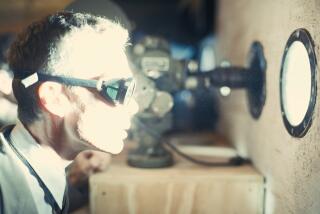Why itâs time for scientists to become cinematic superheroes
The new film âRadioactiveâ is a portrait of scientist Marie Curie, the first woman to win the Nobel Prize and still the only woman to win it twice.
Directed by Marjane Satrapi from a screenplay by Jack Thorne, the film stars Rosamund Pike as Curie; Sam Riley as her husband and collaborator, Pierre Curie; and Anya Taylor-Joy as their daughter Irène, who would herself go on to win a Nobel Prize. Besides telling the story of the Curiesâ romance and Marieâs life and career after Pierreâs untimely death, the film flashes forward for scenes that show the impact of their work in discovering radioactivity, from cancer treatments to the atomic bomb at Hiroshima and the nuclear disaster at Chernobyl.
âRadioactiveâ premiered at last yearâs Toronto International Film Festival (and is now available on Amazon Prime Video), but its release arrives within a raging cultural and political debate on the role of science in fighting a global pandemic. And the movie can be seen not only as a biopic of Marie Curie but also as a spirited defense of science itself.
Thatâs just fine by Satrapi.
âThe problem that I cannot understand, first of all, is how can you not like science?â said Satrapi during a recent call from her home in Paris. âScience is basically human beings that were big monkeys and instead of being scared â âOh, thereâs an earthquake, thereâs a flood, thereâs a volcanoâ â instead of being scared they try to understand the secrets of nature, discover them and understand what are the rules, which brings you to mathematics, astronomy, biology, chemistry, physics.
âThis is what science is. The curiosity of the big monkey who tries to understand and therefore he becomes a human being,â said Satrapi. âSo if you deny science, basically you go back to your condition of being a big monkey.â
The film is very sensitive to the unintended ripples of the Curiesâ work and is particularly attuned to the importance of science and the work of scientists on the frontiers of understanding the world.
âI just want to say that our film does not in any way [say] that Marie Curie is responsible for the atomic bomb,â said Pike. âAnd I think thatâs very important to say, just to stress that point that the scientist unveils the mysteries of the world and mankind is the perpetrator of either ill or good with those discoveries.â
Satrapi was nominated for an Oscar for her animated film âPersepolis,â which was based on her autobiographical graphic novel about growing up in Iran. She went on to direct the live-action films âChicken With Plums,â based on her book, and âThe Voices,â starring Ryan Reynolds.
When she was first sent Thorneâs screenplay, she didnât realize it was an adaptation of a graphic novel, Lauren Rednissâ âRadioactive: Marie & Pierre Curie: A Tale of Love and Fallout.â Satrapi was taken by both the boldness of Curieâs character and the presentation of science in the story.
âI thought it was kind of a complete story because, first of all, you talk about the scientists and you actually really do talk about the science,â said Satrapi. âItâs not like the science is in the background.â
Once Pike, an Oscar nominee and two-time Golden Globe nominee, was cast in the lead role, the actress took science classes to prepare. As she explained during a recent phone call from Prague, where she is staying while waiting for production to resume on the upcoming series âWheel of Time,â the benefit of the lessons was twofold.
âIt was putting her in her scientific context,â said Pike. âHer understanding of radioactivity obviously has to come out of what was available knowledge at the time, not what we know now. And when she was distilling something or trying to evaporate a solution, what was she looking for? I had to have thoughts in my head that werenât, âWhere am I going to go on vacationâ or âI wonder what I should do with the kids on my day off.â It has to be thoughts that are related to her.
âAnd then I had to learn how to do all those technical things with my left hand, because she was left-handed. So youâre handling this flask like you do it all the time,â said Pike. âAnd Iâm very particular about my hand inserts on every movie, Iâm very reluctant to let them double my hands because I feel that the way the character handles something is very important. All the shots of her scraping away at this crystallization, thatâs all me.â
Among the experts the production used to ensure the science in the film was as accurate as possible was Csaba Barta, an associate professor of chemistry at Semmelweis University in Budapest. (The movie was filmed on location in Budapest and Spain.)
âTo depict science is not very easy, especially to show it in an interesting way in a movie,â said Barta during a recent call from Budapest. âAnd of course nuclear fission is something you canât see, radioactivity you canât see. Therefore itâs really challenging to try to show it on the screen.â
Barta helped go through the script to be sure scientific terminology was used correctly and also assisted in assuring that the laboratory equipment was set up as accurately and as historically specifically as best as possible. He said some of the scientific glassware seen in the film was sourced from the disused basement storeroom of a high school in Budapest.
For Satrapi, the scriptâs emphasis on science and the repercussions of Curieâs work set it apart from more conventional biographical stories.
âIâm not really a fan of biopics,â said Satrapi. âIn biopics they make people look like not real people. Youâre going to become some kind of symbol of a human being that doesnât exist.â
She had a different reaction when she first read the screenplay that became âRadioactive,â encountering what would become the filmâs depiction of Curie.
âI had in front of me a human being, who was not perfect,â Satrapi said. âSometimes she was not right. Sometimes she was overreacting. All of that made me love her even more because I could see that in front of me, somebody who I can relate to and everybody can relate to.â
The storyâs depiction of Curie has particularly modern resonances as well. Throughout the film she can be brash, confident and headstrong, such as when she tells Pierre Curie that his mind is fine but hers is finer. She also refuses to be seen as a victim even when circumstances turn against her, noting at one point that her problem is not being a woman but rather a lack of funding and resources. Then, as it would now, this often gets her labeled as difficult when those same behaviors would generate a much different response if they were coming from a man.
âItâs very bizarre that we will call her difficult,â Satrapi said. âWe accept very easily the fact that a man would be a genius and would be a difficult person. Heâs not even a difficult person, it becomes almost his quality to be like that. As soon as it comes to women, we have to be like whipped cream, we have to be soft and a little bit romantic.
âBut imagine if youâre the only human being in the whole world who has two Nobel Prizes in two different fields, chemistry and physics,â Satrapi said, noting one of Marie Curieâs many accomplishments. âSo obviously youâre focused and need your focus. I donât know why it should be a problem. Sheâs a genius. So itâs OK that she would be difficult.
âAnd also I think that all women, they have to misbehave a little bit. By behaving good we never achieve anything,â said Satrapi.
I think that all women, they have to misbehave a little bit. By behaving good we never achieve anything
— Marjane Satrapi, director of âRadioactiveâ
Pike similarly felt that the filmâs depiction of Curie was crucial to what she represents, both in her time and to ours.
âWe made this film with an uncompromising, direct, spirited Marie Curie, and people say sheâs unlikable or whatever. Itâs complete double standards because sheâs a woman,â said Pike. âAnd I happen to find it really appealing in her. So the first time somebody said, âOh, sheâs kind of a bitch,â I just thought, well, that says way more about you than it says about her.
âBecause if she was sort of sweet and lovely, she might be the girl you wanted to marry but she wouldnât be the girl Pierre Curie wanted to marry, and she wouldnât have been the woman to win two Nobel Prizes,â said Pike. âI find her directness sort of eccentric and appealing. Itâs funny that Marjane and I arrived at that version of her independently of one another. And we both saw her exactly the same â surprising, sometimes rude, but in a way that starts to become charming.â
Satrapi wants the filmâs depiction of Curie and science itself to be inspirational to young people, in particular young women. She noted that fewer women studied mathematics in 2020 than in the 1980s, and that many women were pilots in the early days of aviation before it came to be seen as a male-dominated field.
âIn 2020, we teach our girls they have to be pretty and they have to be convenient,â Satrapi said. âThere are like 10 qualities before being pretty and convenient â like loyalty, justice, being a good friend, being somebody with integrity â all these qualities come before being convenient. So I hope that young girls, and boys even, they will see that and they will think that science is cool and, more than that, intelligence is cool.â
For Pike, the film presents both the scientist and the science itself as heroic, something intended to inspire people to achieve more.
As she said, âWe presume a child will relate to Wonder Woman more readily than sheâll relate to Marie Curie. But why?â
More to Read
Only good movies
Get the Indie Focus newsletter, Mark Olsen's weekly guide to the world of cinema.
You may occasionally receive promotional content from the Los Angeles Times.











